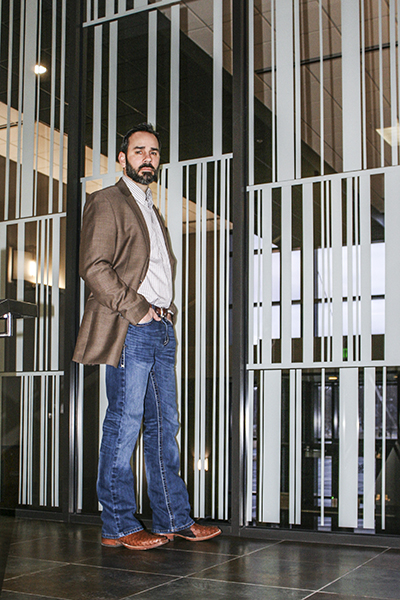|
Getting your Trinity Audio player ready...
|
On paper, Ryan Riggs is the director of real estate design for O’Reilly Auto Parts, but he describes himself as more of an orchestral conductor or sports coach–someone whose success is measured through his ability to direct, motivate, and inspire those who work with him. His role is primarily to help those on his team prosper and grow, and he sees real estate as a support function for O’Reilly’s primary business as an auto parts retailer. “We are an auto parts company, not a design firm,” he says. “Therefore, I recognize my role as providing attractive yet efficient and economical buildings to give the operations team our best chance of success.”
Prior to joining O’Reilly, Riggs’s professional background encompassed both the construction and the automotive industries. He started off in his father’s family business supplying wholesale auto parts, but eventually sought independence and was drawn to the satisfaction of building something from the ground up.

Riggs founded his own construction company, which he ran successfully for a number of years. He was later approached by a national construction and facilities company that was looking to expand its construction capabilities and service a few target customers in the area, O’Reilly being one of them. After about six years of working together in that capacity, O’Reilly asked Riggs to come on board full-time. As a native of Springfield, Missouri, where O’Reilly is headquartered, Riggs jumped at the chance to join the local team, which also has a great reputation from a customer and vendor perspective.
O’Reilly continues to expand into new markets at an impressive rate of approximately 200 new stores per year throughout the United States. As its Missouri headquarters is seated in the heart of the Ozarks, it saw a fair amount of its initial growth in rural markets. Riggs adds that the company is very grounded in its roots and therefore takes pride in its location. While the company continues to grow and enter more urban areas, Riggs’s team is focused on streamlining the design and permitting processes to maintain O’Reilly’s mission of opening stores on time, while continuing to keep its real estate footprint cost-effective.
O’Reilly’s real estate team maintains a prototype design for its stores based on “operational efficiency” and “expense control.” “We try not to spend a single dollar that does not add value to the customer or shareholder,” Riggs explains. As such, the team doesn’t alter the prototype often, save for a few tweaks to keep up with customer feedback, evolving technology, and code compliance. “Our success comes from providing the best possible inventory, service, and prices,” he continues, “rather than fancy buildings loaded up with bells and whistles.”

However, as O’Reilly has been diving into more urban markets, Riggs’s team has come across more design criteria and regulations, such as overlay districts, that its buildings must adhere to in order to be permitted. In these situations, his team is tasked with negotiating with the municipality’s city planning and economic development groups, finding the best solution to maintain O’Reilly’s brand strategy while still meeting location-specific criteria set by the local government. Riggs says the company’s vendor partners are instrumental in this process of handling certain regional challenges, such as wind or snow loads. He cites Chief Industries, Inc. in particular as having extensive experience in overcoming these obstacles efficiently.
As a negotiator, Riggs stresses that openness and honesty is the best policy and balances a business approach with reasonable compromise. “I am going to fight for our company, but at the same time, we don’t want the reputation of being difficult, understanding that they have an agenda as well,” he says. “We respect that, and our reputation in the market is what drives every decision that we make as a company, including real estate and design.”

He explains that, for a current potential real estate acquisition, the cost to renovate the building to the city’s design standards is cost prohibitive in terms of the sales forecast in this particular market, adding that he strives to reach an agreement by pointing out more moderate renovations within O’Reilly’s budget that should meet the highest design priorities for the site. “I appealed to the fact that I presented a reasonable design, keeping with the surroundings, and that because there is some residential behind the site, all four sides of the building got some treatment,” he says. “At the end of the day, it has to make good business sense.”
When it comes to growing the team at O’Reilly, Riggs stresses the importance of finding like-minded, culturally aligned individuals. When he was working with O’Reilly as the director of strategic accounts for a national construction and facilities company, there was a great match between them in terms of culture and values. What he looks for when adding new hires is essentially the same fit. “Our current employees have been great in referring past coworkers and classmates that they believe would fit the culture and have the experience and skill set we are looking for,” he says.
During O’Reilly’s current market expansion, Riggs’s team has kept up by refining its organizational structure. “We’ve grown tremendously in terms of capacity and structure. I’ve restructured and developed subdepartments within the real estate design department, which increases efficiency immensely and gives individuals ownership over their respective pieces,” Riggs says. The department is divided into teams that specialize in new store development, remodels, existing store renovations, and build-to-suits. While this organizational structure allows for team members to specialize, Riggs mentions that it does include cross-training so that members of one team can jump on board to help another if need be.
One of the biggest benefits to this organizational structure, Riggs explains, is that it gives individuals the opportunity to really own their contributions to O’Reilly’s success. “We talk about how their roles matter. It might seem like a small piece of the puzzle, but I make a point that everyone knows their piece is integral to the whole process,” he says, and also encourages everyone in his department to come out of their shells and take on new challenges. “Growing people by maximizing their talent and building their confidence is the most rewarding, important part of my job; in my estimation, it’s the biggest contribution any leader can make to their organization.”


